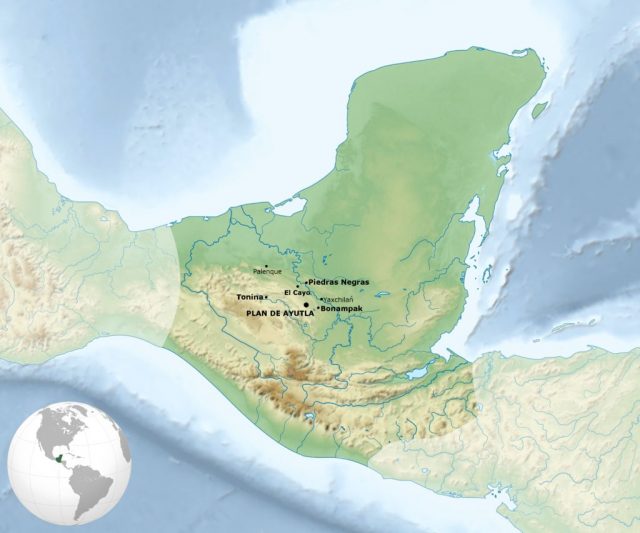An ancient Mayan kingdom has been found in someone’s backyard. It’s taken a quarter of a century but evidence of Sak Tz’i’, the ancient kingdom of the Maya, was recently unearthed following nearly 2 years of excavations.
First heard about in 1994, Sak Tz’i’ (or “White Dog”) was referred to via Mayan inscriptions. Its location was a mystery however. Since 2018 anthropologist Prof. Charles Golden of Brandeis University, bioarchaeologist Andrew Scherer from Brown University and others have been exploring property owned by a Mexican cattle rancher. The area is now known as Lacanjá Tzeltal. Many archaeologists consider the modern day site of Plan de Ayutla as a very strong candidate for the ancient Mayan kingdom site of Sak Tz’i’


What did they discover? IFL Science notes “A preliminary count of structures… yields 120 structures and 56 carved monuments, though there are likely many more that have been looted and currently unknowingly reside in public and private collections.” It’s believed this site used to be the kingdom’s capital.
The extraordinary finds of the ancient Mayan kingdom include what’s left of a royal palace and also ruined pyramids – for example, a 45 ft pyramid is said to have dominated the city’s northeastern side. A courtyard covering 1.5 acres called the ‘Plaza Muk’ul Ton’ (‘Monuments Plaza’) was a ceremonial center. There’s even evidence of a ball court where, according to Futurity, “players kept a solid rubber ball, sometimes as heavy as twenty pounds, bouncing back and forth across a narrow playing field using their hips and shoulders.”
The modern Mexican ranch is bigger than a typical backyard, but the fact it hosts the remains of a royal center is astonishing enough. What led Prof. Golden’s team to the ranch in the first place? That’s possibly the most eye-opening part of the story.
They owe it all to graduate student Whittaker Schroder and his trip to the state of Chiapas. If he hadn’t decided to stop at the roadside for carnitas, a pork dish, he wouldn’t have met a friend of the rancher. The unnamed cattle wrangler had in his possession an ancient tablet, some 2 ft by 4. This artifact bore the images of a water serpent and also Yopaat, a dancing rain god amongst other amazing details. Schroder was in the area visiting digs and looking for some dissertation-based inspiration. Safe to say, he certainly found it that day!
“Because all previously known references to the kingdom came from looted monuments or texts found at other Maya centers, the location of the Sak Tz’i’ kingdom’s capital has been the subject of ongoing modeling and debate among scholars” writes Prof. Golden and colleagues in the Journal of Field Archaeology. They must have been surprised to find a student stumbling across it in the search for sustenance.
So what was it like digging on a ranch? A long process as it turned out, and that was before they set spade to soil. It took half a decade for permissions to be granted so the team could commence work. “In Mexico, cultural patrimony like ancient Maya sites are considered the property of the state,” Futurity writes, “so the rancher worried that the government might confiscate his land. Golden and Scherer worked with him and government officials to make sure that this wouldn’t happen.”
Aside from that, excavators had to mind the cows, who were liable to take a tumble into the holes. Not to mention all those hoof marks and piles of dung!
Prof. Golden and co are keen to point out that “breakthrough discoveries often come as the result of collaborations with local communities and other stakeholders.” Having the locals on side was vital. “Their involvement is central to our research and conservation efforts, and their contributions are too often unrecognized in the public media.”
Related Article: Enormous Mayan Palace in Great Shape Discovered Deep in the Jungle
Speaking of boundaries, the find shows how Sak Tz’i’ coped with hostile elements. It was a kingdom but not exactly the biggest in the land. That less formidable position meant it needed masonry walls on one side and a stream with steep walls on the other to repel undesirables.
The archaeologists are turning to the LIDAR (Light Detection And Ranging) mapping system for the next stage in their research. This will train lasers on the site in a bid to delve deeper below the surface, without the need for digging. It’s hoped light beams will throw even more light on the precious Mayan discovery.

